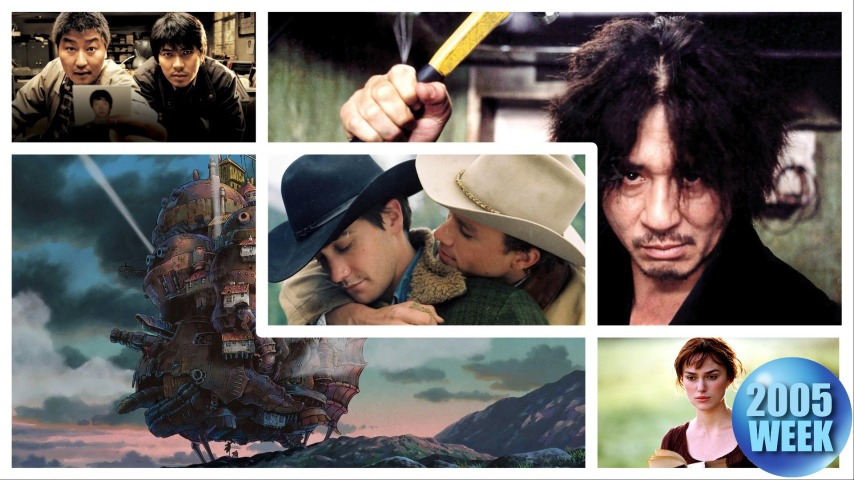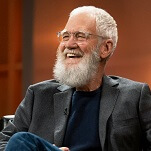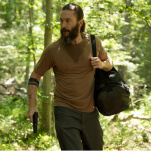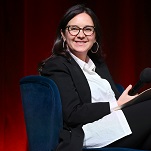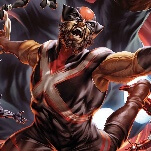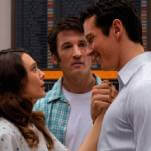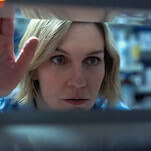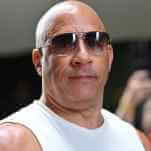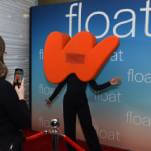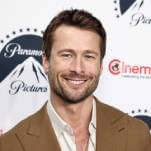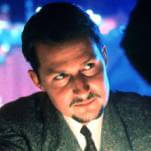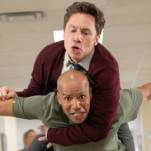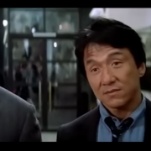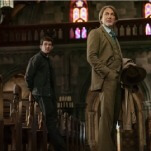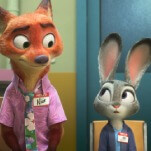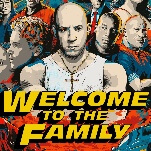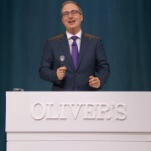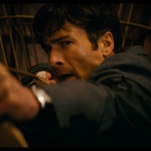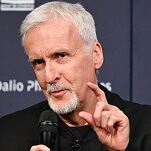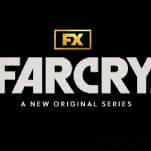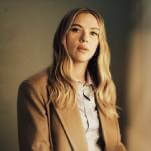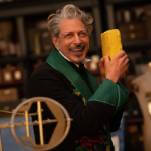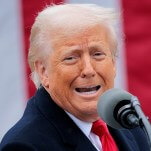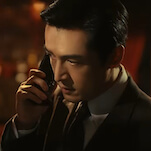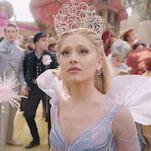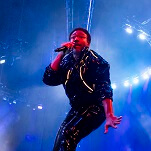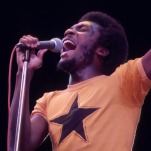21. Me And You And Everyone We Know
Despite the occasional misinterpretation of her whole deal, Miranda July has beaten that rap handily as an artist, filmmaker, and fiction writer. That starts, in the mainstream, with Me And You And Everyone We Know, which remains one of the most arresting debut films of the century. In this more digitally savvy version of the “hyperlink cinema” popularized around this time (see Crash, Babel, and other sagas of would-be global import), July follows a group of interconnected characters through a series of strange communications—including the single most memorable cinematic emoticon ever devised. Some are uncomfortably intimate, involving the clumsy or nascent sexuality of minors; others are cautiously romantic, like the blossoming relationship between Christine (July) and slightly daft shoe salesman Richard (John Hawkes). The movie is not explicitly or singularly about the internet, but July brilliantly evokes the desperation and alienation that our digital lives ushered in with the new century, on and offline: When an older man leaves messages in his window for a pair of experimenting teenage girls, it’s like an IRL away message. Shot on bright but lo-fi video, Me And You And Everyone We Know is a small miracle of a movie, a mini-Magnolia that’s as funny, discomfiting, and tender as ever after two more decades of digital frailty. [Jesse Hassenger]
20. Kung Fu Hustle
Though Shaolin Soccer was Hong Kong parody king Stephen Chow’s American breakthrough, Kung Fu Hustle more clearly captures the oddity of his comic brand. A grotesque, manic, lowbrow, Looney Tunes take on the typical martial arts smackdown, the terrorization of Pigsty Alley by the Axe Gang takes on an epic scale that Chow had never before broached. Incorporating all the physical gags, escalating surreality, and visual inventiveness of his prior, smaller-scale films like The God Of Cookery, the writer-director-star’s cartoonish wuxia sits comfortably alongside the crossover examples of the genre that had made an impact Stateside in the years immediately prior. For those more familiar with Chow’s frenetic mo lei tau sensibility, additional fun can be found in just the many older action stars who get goofy for the film, including Yuen Wah, Yuen Qiu, Bruce Leung, and in the intricacies of Yuen Woo-ping’s choreography. [Jacob Oller]
19. Pride & Prejudice
A decade after Andrew Davies delivered a definitive TV adaptation of Jane Austen’s Pride And Prejudice, Joe Wright did the same for the big screen. While the debate over which Mr. Darcy did it better may never end (a.k.a. the Wet White Shirt vs. Hand Flex Conundrum), the real joy is how the two adaptations bring out different sides of Austen’s most beloved novel. While Davies is faithful to the story beats, period details, and satirical edge of Austen’s work, Wright embraces a lush romanticism and lived-in worldbuilding that makes the story even more accessible to modern audiences. His take on Elizabeth Bennet (Keira Knightley) and Mr. Darcy (Matthew Macfadyen) has smoking-hot chemistry, whether the pair are fighting, dancing, or nearly kissing in the rain. But the movie’s true strength lies in its small observational details, from the casual way the Bennet sisters hang out when male callers aren’t around to those excellent boiled potatoes. Intimate, roving camerawork makes the period world immersive, rather than glossily removed. And the real grace note is how the adaptation reimagines Darcy’s judgmental arrogance as a manifestation of his social anxiety, an idea that both grounds the character work and anchors the comedic tone. It all adds up to a dreamy, funny, deeply emotional period romance that bewitches both body and soul. [Caroline Siede]
18. Mysterious Skin
Gregg Araki’s adaptation of Scott Heim’s 1995 novel is arguably the director’s most harrowing yet tender film. Set in the prototypical American enclave of Hutchinson, Kansas during the late ’80s and early ’90s, the film follows two outcasts whose childhood trauma manifests in vastly different ways as they come of age. After being molested by his baseball coach as a child, Neil (Joseph Gordon-Levitt) develops a preference for much older men, eventually garnering a steady roster of local clients as a sex worker. Conversely, Brian (Brady Corbet, nearly two decades before helming The Brutalist) is obsessed with UFOs and extraterrestrials after unearthing a hazy childhood memory of blue-bodied beings probing him. While Neil eventually moves to New York with his best friend Wendy (played with graceful depth by the late Michelle Trachtenberg), Brian stagnates in Hutchinson, becoming increasingly agoraphobic. Even during the film’s most gritty and disturbing moments, Araki maintains an air of delicacy, a noticeable departure from much of his intentionally edgy filmography. While his Teenage Apocalypse trilogy is radical in its sexual rebelliousness, Mysterious Skin is a poignant portrait of queer survival in a hostile society. [Natalia Keogan]
17. Saving Face
By the mid-2000s, the sparkling rom-com burst of the ’90s was starting to curdle into something more generic and formulaic. But writer-director Alice Wu upended that trend with her delightful debut feature, Saving Face, a lesbian love story and mother/daughter dramedy set against the backdrop of a tight-knit Chinese-American enclave in Flushing, Queens. Saving Face starts as the story of successful surgeon Wil (Michelle Krusiec) trying to hide her burgeoning romance with modern dancer Vivian (Lynn Chen) from her traditional mom Hwei-Lan (Joan Chen)—until Hwei-Lan shows up on her daughter’s doorstep pregnant, unwed, and kicked out by her own parents. What follows is a funny, thoughtful look at how three very different women try to find the balance between living and loving authentically without abandoning the community that raised them. Elevated by its specificity and three great central performances, Wu’s empathetic film is a reminder that the rom-com genre has long been a haven for women’s stories that don’t get told elsewhere. Saving Face is honest while still being joyful and heightened while still being grounded in reality. And though it was undervalued at the time of its release, a well-deserved Criterion Collection addition has cemented its legacy as a trailblazing queer rom-com touchstone that still feels just as fresh today. [Caroline Siede]
16. War Of The Worlds
One of the great, anxious movies about fatherhood, Steven Spielberg’s War Of The Worlds pits bad-dad longshoreman Tom Cruise against an alien invasion ready to shatter any and all illusions of national safety. Dominated by images of ash and dust and crumbling buildings, Spielberg’s post-9/11 disaster film flits between its grounded destruction and the looming spectacle of the tripods. Odd for a Spielberg film, in that the terror feels far more visceral and honest than any of the human connection ever does, War Of The Worlds is best at its coldest, its most helpless, its least willing to please a crowd. This is the modernized spirit of H.G. Wells, tormenting the frightening responsibilities of adulthood with powers outside of any individual’s control. [Jacob Oller]
15. The Descent
There are shots of puddles in Neil Marshall’s cave-diving nightmare The Descent that still have the ability to paralyze you. Knowing someone’s going to squeeze through a narrow hole in the wall creates a claustrophobia so visceral that it can be hard to breathe while watching the movie. And it only gets worse the deeper it goes. One year after a tragedy that took Sarah’s (Shauna Macdonald) family, six thrill-seeking friends reunite for a spelunking expedition in Appalachia—and it could not go more poorly. As they enter the cave, trip leader Juno (Natalie Mendoza) tosses the map and lowers them deep into the earth, leaving them with little chance of survival. The intensely tight quarters, impenetrable darkness, and relentless stamina needed to traverse the caves would be one thing, but mole people? Coming off his impressive werewolf actioner, Dog Soldiers, writer-director Neil Marshall doesn’t shy away from going full creature feature, and does so with conviction. His careful escalation stacks problem on top of problem, remembering that even with albino, sound-sensitive crawlers messing about, the women still have to navigate a supposedly undiscovered cave system with limited supplies and even less light. [Matt Schimkowitz]
14. Tropical Malady
Like his later works Uncle Boonmee Who Can Recall His Past Lives and Memoria, Thai filmmaker Apichatpong Weerasethakul’s Tropical Malady is a beguiling experience. Led into the jungle by its two stars (Banlop Lomnoi and Sakda Kaewbuadee), the film creates poetry by contrasting the mystical and the natural, the romantic and the mundane. That’s represented in the structure, too: Divided into two, with the two leads playing different roles, Malady first explores a burgeoning romance, then, a fable about a soldier hunting a tiger shaman. Each side echoes the other, but Weersethakul keeps the interpretation and meaning elusive by layering banal meetings and playful movie-theater fondling atop the mysterious forces found in the dense thicket of the jungle. Vibrant emotionality holds the center of the film regardless of how otherworldly it becomes. It’s a rich text that, like its characters, avoids easy classifications and aspires for transcendence through observation. Weerasethakul’s vibe-based romance enchants in ways that feel impressively modern as its slow-moving camera and intricate sound design shift meaning from one moment to the next. [Matt Schimkowitz]
13. Kiss Kiss Bang Bang
Shane Black had been writing memorable movies for two decades by the time he finally got a chance to direct his own. The Lethal Weapon and Last Action Hero piss-taker made his debut with a hilarious neo-noir that took advantage of the snappy chemistry between mid-comeback Robert Downey Jr. and Val Kilmer, hungry to do a comedy. The chatty, snide, breezily meta remix of hardboiled tropes runs on RDJ’s jittery energy and Kilmer’s gay straight man as much as it does Black’s script, which is just pleased enough with itself to delight writing geeks and genre devotees alike. Not to mention, it’s a great Christmas movie. [Jacob Oller]
12. Batman Begins
If X-Men launched the modern superhero movie era, Batman Begins gave it a new standard, offering a different, but no less stylized, take on the well-worn Caped Crusader. However, director Christopher Nolan found a tone that was idiosyncratic for the time, adjusting the comic-book trimmings into realistic-sounding justifications. Of course, this is still a movie where Batman goes to ninja college before mining his tech company’s paramilitary R&D department for gadgets. It’s no more realistic than anything Tim Burton did, but it sells itself with such confidence that it’s hard not to get wrapped up in its fantasy. Don’t get it twisted, though: The plot is classic Batman. But just because it’s treated more sincerely doesn’t make it any less entertaining—and funny as the movie once again dispels Nolan’s humorless reputation. Batman Begins revolutionized superhero movies by taking a beloved character and digging, seriously, into more of what was already there on the page. It was the first time a Batman movie focused on Batman’s pathos, motivation, and technique. As it turns out, that’s a very compelling idea for a movie. [Matt Schimkowitz]
11. The New World
The New World didn’t just re-establish Terrence Malick as a somewhat less reclusive auteur of unmistakable tone poems; it also signaled the direction of his 21st -century style as he reached back to the 17th. The founding of Jamestown and a romance between John Smith (Colin Farrell) and Pocahontas (Q’orianka Kilcher) is an oft-told story, appropriated by Disney as recently as a decade before this version. What might have been a straightforward historical romance-adventure (or, for that matter, grim polemic) is instead startlingly and gracefully in touch with the natural world around the characters, clear-eyed about the beginnings of a genocide yet matter-of-fact about the characters’ hardships, foolishness, and occasional transcendence. The relationship between Smith and Pocahontas doesn’t muffle the story’s tragic dimensions; instead, Malick uses narration, unconventionally low-coverage cinematography from Emmanuel Lubezki (in their first of many movies together), and quietly sensitive performances from Farrell and Kilcher to get at something more experiential. If the movie sometimes appears to wander in its longest available cut (three different versions are in its Criterion package), it builds to a spectacular ending, following Pocahontas to London with John Rolfe (Christian Bale) and into a new world of her own. In any form, though, The New World gives historical epics a good name. [Jesse Hassenger]
10. The Squid And The Whale
In the decade between his 1995 debut Kicking And Screaming (not to be confused with the 2005 soccer comedy Kicking & Screaming) and The Squid And The Whale, Noah Baumbach was treading water. As time went on, it was starting to look like he was flailing. But two personal connections—his relationship with Wes Anderson, who Baumbach would co-write The Life Aquatic with and who would produce The Squid And The Whale, and his relationship with his family—would spark Baumbach’s sharp, strange, sad divorce comedy. A powerhouse cast (Jeff Daniels, Laura Linney, Jesse Eisenberg, Owen Kline, Anna Paquin) balances out the flavors of Baumbach’s semi-autobiographical and deeply Brooklynite tale, adding sweetness to the sour cynicism and salt to the emotional wounds. As two brothers break down in the wake of their parents’ marriage doing the same, the funnily specific foibles of youth in crisis devolve; that these idiosyncratic problems persist through middle-age takes on a thudding melancholy, though one invigorated by the script’s honesty. [Jacob Oller]
9. The Holy Girl
Following her fetid swimming-pool-as-society film La Ciénaga, Argentine filmmaker Lucrecia Martel cemented herself as an arthouse darling with The Holy Girl, another story of cultural rot and familial complexity. A Catholic schoolgirl (María Alché) who lives at her mother’s hotel is secretly yet publicly groped by a middle-aged doctor (Carlos Belloso) staying there for a medical conference. The ensuing emotional fallout, his perverse guilt and her conflicted feelings of resentment and excitement, drive a quiet cat-and-mouse plot that entwines sexual awakening and religious fervor into a layered portrayal of teenage self-discovery and self-delusion. That the girl’s divorced mother (Mercedes Morán) also starts flirting with the doctor only makes Martel’s story more prickly, more uncomfortable, more likely to have audiences loosening their collars. It’s this claustrophobia, closing in through messy close-ups and too-tight frames, that continues on from La Ciénaga, with Martel finding a way to translate humid, heavy, hard-to-breathe air into the language of film. [Jacob Oller]
8. Caché
Unpredictably playful and relentlessly painful, Michael Haneke’s Caché teases the audience and characters alike with footage eventually revealed to be increasingly threatening tapes taken outside and around the home of Anne (Juliette Binoche) and Georges Laurent (Daniel Auteuil). From this state of formal readjustment, the film’s Lost Highway-like paranoia evolves into something both intimately personal and allegorically political, all while maintaining an edgy tension throughout its disquieting stillness. Watching it is like being a character in the movie, constantly questioning what’s in front of you and constantly negotiating its larger meaning. And, unlike its Lynchian counterpart, there’s little in the way of shock or surrealism (with one major exception) to provide even a gasp of limbic relief. In this quotidian nightmare, Haneke has everyone right where he wants them. [Jacob Oller]
7. Munich
Six months before Daniel Craig rebooted James Bond with a semblance of a conscience, Steven Spielberg made his Bond fantasies a reality with the vengeful espionage thriller Munich. He even brought Daniel Craig along with him. Munich follows Avner (Eric Bana), a Mossad agent tasked with assassinating the architects of the Munich massacre, in which 11 Israeli Olympians were killed at the ’72 Munich games. While the movie has no shortage of thrills, Avner’s psychological unraveling powers the plot. A young father-to-be, separated from his family for a mission he’s unsure of, Avner begins to humanize his targets and empathize with their cause, much to the chagrin of the Zionist organizations who boycotted the film upon release. A decade after Schindler’s List, Spielberg questions the cost of Israel’s limitless right to defend itself through a tit-for-tat game of revenge that has only become more destructive in the decades since. “Whatever you are doing, somebody else is paying for it,” a Mossad accountant tells Avner. Spielberg reveals that price in every scene. [Matt Schimkowitz]
6. Howl’s Moving Castle
A desperate anti-war plea from Studio Ghibli’s Hayao Miyazaki, in one of his most imaginatively free expressions, Howl’s Moving Castle and its mechanized Baba Yaga hut tromp through endless exquisite landscapes in service of a glistening, bittersweet fairy tale. Joe Hisaishi’s carnival-like score and one of Ghibli’s best dub casts (Lauren Bacall, Jean Simmons, Billy Crystal, and especially Christian Bale all doing great work) counterbalance the corruption and violence raging throughout the film. War pushes magic to its limits as the pacifist wizard Howl and Sophie, the cursed girl swept up into the drama of his inner circle, struggle to adapt to their new circumstances and the harsh world outside. The ways the two change (both transform over the course of the film, into a wizened old woman and a raven-like monster, then back again) reflect their battle-torn nation, and the cobbled-together construction of the castle they share. Time breaks us down, and we rebuild in response, different yet persistent. [Jacob Oller]
5. A History Of Violence
A History Of Violence is an atypical Cronenberg vehicle. The filmmaking is linear and relatively straightforward, and its most grotesque transformation is the Philadelphia accent Viggo Mortensen adopts towards the end of the movie. But it’s a superb example of Cronenberg as Wife Guy, an underappreciated aspect of the Canadian body-horror legend that’s reflected in the visceral attraction between Indiana everyman Tom Stall (Mortensen) and his more successful spouse Edie (Maria Bello). The film also interrogates the capacity for violence inside every human being, presupposing it as an inborn talent like natural athleticism or a good singing voice. Many directors have studied the savage underbelly of suburbia. Only Cronenberg makes it feel like a genetic mutation. [Katie Rife]
4. Grizzly Man
Bear enthusiast and conservationist Timothy Treadwell filmed over 100 hours of footage during the last five years of his life. This includes the fatal encounter he and his girlfriend, Amie Huguenard, had with one of these predators in Alaska’s Katmai National Park. Famously, Werner Herzog refused to include the audio of their mauling (Huguenard had not yet removed the lens cap when the grizzly attacked) in his landmark documentary. But even without the explicit details, the German auteur presents an entrancing portrait of Treadwell, who had long established himself as one of the world’s foremost ursid admirers, in just over 90 minutes. For 13 consecutive summers, Treadwell lived amid the bears on the Alaskan island, purporting that his presence deterred would-be poachers; instead his regular presence may have caused the bears to eventually see him as a viable food source, particularly as he extended his stay during the bears’ pre-hibernation, food-focused season. In truth, some of the footage that Treadwell shot is more cinematic than anything Herzog captures for the project (one scene, in which wild foxes appear amid bucolic forest to accompany the zany nature lover on a walk, is truly remarkable), but it’s the director’s distinctive narration that makes Grizzly Man into a masterwork. [Natalia Keogan]
3. Oldboy
One of the grisliest revenge films in a decade full of stylishly violent vengeance quests, Park Chan-wook’s first international hit, Oldboy, is also the most elegant. The movie follows asshole businessman Dae-su (Choi Min-sik) who was kidnapped after a night of heavy drinking and imprisoned for 15 years. Released into a field without learning any cause for his captivity, Dae-su re-enters society as a bad-luck charm, casually inspiring people to suicide when he’s not revolting sushi bar patrons. Revealing himself to be a student of the Hitchcock game (except with more live octopus eating) Park supplements his clockwork plotting with chaotic action scenes that portend the writer-director’s persistent high-and-low aesthetic, with grace notes of violence and horror. The film’s wildly influential, hammer-heavy corridor fight still hits, but so does its tragic ending. Oldboy evolves into an oppressive watch, one that traps the viewer long after the credits roll, but Park’s ability to make that journey palatable is seen in his masterful staging of action and suspense, carefully stacking the pieces and then knocking them down in an unforgettable final act. [Matt Schimkowitz]
2. Memories Of Murder
Bong Joon Ho’s breakthrough thriller Memories Of Murder investigates the real-life Hwaseong murders, which occurred in rural South Korea between 1986 and 1991. Opening on a sun-kissed paddy field, the idyllic scene gets draped in Blue Velvet as Detective Park (Bong muse Song Kang-ho) unearths a woman’s corpse stuffed in a drain pipe. Soon, Memories‘ mystery settles into a downcast investigation for three stubborn detectives to bungle. Led by Park, the team bickers over intuition versus coercion and data over confession. But the film’s biblical rainfall and contaminated crime scenes, and the detectives’ desire to close the case rather than solve it, keep the killer from their grasp. Through long takes, cluttered frames, and desaturated colors, Bong floods the procedural murder-mystery mundanity with humor, tension, and misery. Memories Of Murder arrived in America in 2005, splitting the difference between David Fincher’s landmark films Seven and Zodiac with a grim take on a genre that still can’t shake these Memories. [Matt Schimkowitz]
1. Brokeback Mountain
Crash may have won Best Picture at the 78th Academy Awards, but both then and now Brokeback Mountain feels like the definitive American film of 2005. In the conservative milieu of George W. Bush’s second term and as the fight for marriage equality just began to reach a turning point, it’s hard to overstate how seismic it was for two rising young Hollywood stars to lead a “gay cowboy movie.” But two decades removed from that socio-political context, what stands out most about Brokeback Mountain is the aching sense of loneliness and longing that director Ang Lee and his cast capture. This adaptation of Annie Proulx’s acclaimed short story uses the vistas of Wyoming to reflect the ever-shifting relationship between ranch hands Ennis Del Mar (Heath Ledger) and Jack Twist (Jake Gyllenhaal). In their youth, the sprawling mountains represent freedom where the young couple can live as they want to; in middle age, they become a barrier that keeps them locked away from a truly integrated life in the homophobic, hypermasculine West. Ever the humanist, Lee depicts a world in which violence, passive aggression, and repression are the only languages most people know how to speak—even as nearly every character in the film is yearning for a sense of emotional connection. Brokeback Mountain deconstructs the heroic tradition of the stoic American cowboy, while unabashedly embracing the tropes of a classic romantic tragedy. And, with all due respect to The Dark Knight, it features a career-best performance from Ledger as the anchor that holds it all together. [Caroline Siede]
